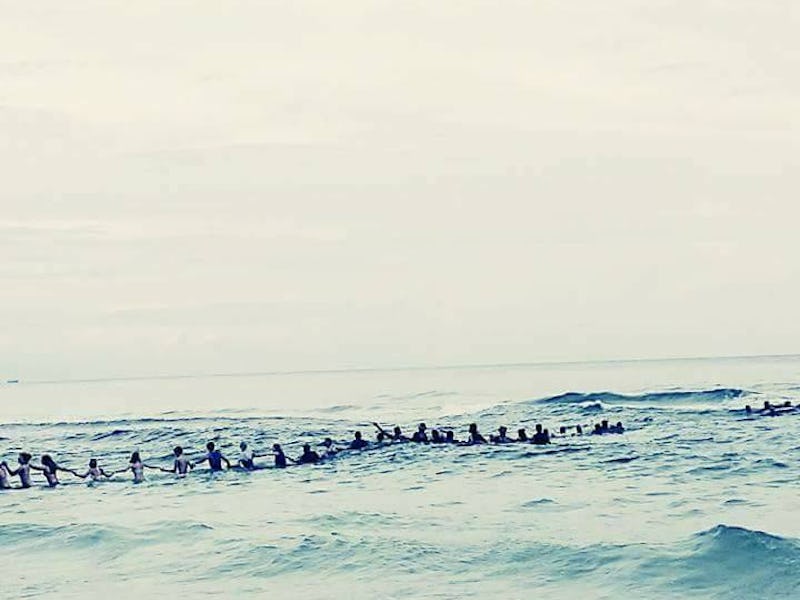The Human Chain Beach Rescue Was a Dangerous Gamble, Say Experts
Don't get in the water if you don't know what you're doing.

On Saturday in Florida, an estimated 80 people linked arms in the ocean to create a human chain in an attempt to rescue nine drowning swimmers who were swept out to sea by a rip current at Panama City Beach.
Jessica Mae Simmons, who used a boogie board to reach the struggling swimmers and pull them back to the chain, credits all of the beachgoers who pitched in to get everyone out. “Had we NOT had the surf board, the boggie boards, the HUMAN chain of over 70 inspiring life saving people and just staying calm to get out of the rip tide, we would have never been able to bring them to shore alive,” she wrote in a Facebook post following the incident.
“What really got me was how a entire BEACH jumped into action to save these people,” she continues. “People who COULDNT even swim was part of that human chain. They wanted to help that bad.”
The story is inspiring, both for Simmons’s heroic act and the support team that spontaneously formed behind her. But human chains can put more people at risk and are rarely enough to complete a rescue, warn beach safety experts.
“They’re dangerous because the chain can break if you have a weak link in it,” Francis Smith, a coastal oceanographer at the University of California, Berkeley, tells Inverse. If more people are swept out by the current, you suddenly have a much bigger rescue on your hands. Many drownings result from people going in after someone else, untrained and unprepared, only to find themselves suddenly out of their depth. A rip current is a lot more dangerous than a shark.
And human chains can rarely reach all the way to a drowning person safely. “Human chains are not normally going to be effective for various reasons,” Chris Brewster of the United States Lifesaving Association tells Inverse by e-mail. “First, they only work if the water is shallow enough that everyone’s head is above water. That’s unusual in most areas. Second, if there’s any meaningful surf action, people won’t be able to stay put, as they will be battered by the surf.”
“Panama City Beach gently slopes into the water; the waves were not large and the rip current was not that strong — these factors made the human chain possible,” Stephen Leatherman, a beach expert based in Florida, explained to Inverse by email. “Waves in the Atlantic Ocean are generally larger and beaches steeper, and the large swell waves in the Pacific Ocean would have certainly made the human chain impractical.”
Human chains can only go as far as you can stand, and most drownings don’t happen in water that’s shallow enough to stand in. It’s worth noting that, even in this recent rescue, the human chain relied on people swimming out to the victims and delivering them back to the chain so that they could then be pulled into shore.
But human chains can be a big help, as they were in this case. “I don’t want to discourage anybody from saving another person,” says Smith.
However, if you can’t swim, you shouldn’t go in the water, especially in a rescue situation, even as part of a human chain. If the chain breaks, you’re on your own and you’d better know how to rescue yourself from a rip current.
If you do decide to form a human chain, a little organization and planning can go a long way. Make sure everyone in the water is a confident swimmer, and put the tallest and strongest people at the far end of the chain. Less confident swimmers can join the chain from the beach.
Or better yet, find anything that floats and throw it into the ocean. “If there’s a rip current, you can throw all kinds of floatation,” says Smith. “Throw the cooler in. Empty out a soda bottle, and put the cap back on, and throw it in. It may not be much, but it’s something.”
Getting things that float out to drowning swimmers is one of the best things you can do to help, after you’ve alerted lifeguards and called for emergency responders. Keeping an eye on people in the water is a great idea, too, says Smith.
“People don’t know what to do,” he says. “The impulse is to try to save someone, try to help.” But don’t assume that you have to get wet to do your part. By running up and down the beach collecting lifejackets and floaty toys, you might just save a life.